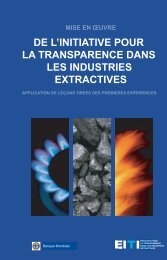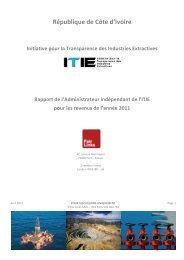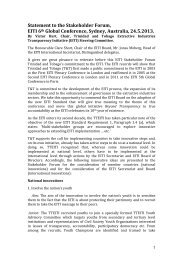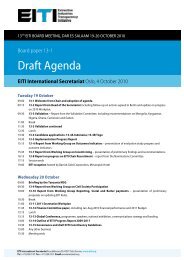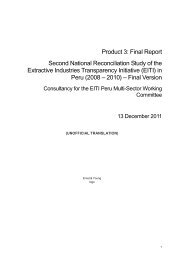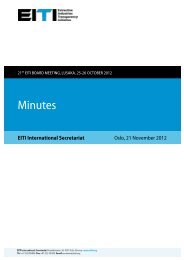Vietnam feasibility study - EITI
Vietnam feasibility study - EITI
Vietnam feasibility study - EITI
Create successful ePaper yourself
Turn your PDF publications into a flip-book with our unique Google optimized e-Paper software.
62<br />
To clarify the way of operation of the <strong>EITI</strong> Committee, most countries have established a Memorandum<br />
to the Committee of <strong>EITI</strong> activities. Each member of the Committee shall sign into the memorandum<br />
to indicate their commitment to the <strong>EITI</strong>, including:<br />
• Commitment on rules and criteria of <strong>EITI</strong>;<br />
• Way of operation and management of <strong>EITI</strong> program;<br />
• Rights and obligation of each unit when signing the Memorandum;<br />
• The description of way to create the <strong>EITI</strong> report;<br />
• The way to administrator or commission an independent auditor.<br />
step 3: determining the scope of the eItI program<br />
Depending on the context of each country, the scope of the <strong>EITI</strong> programs in the countries are different.<br />
Therefore, each country must determine the scope of its programs from an early stage. Here are six<br />
issues that the country must consider in determining the scope of the <strong>EITI</strong> program:<br />
• Theprocessofcomparison(intermsofdocumentsfromtherevenueresource)ortheauditprocess:<br />
a basic decision on the scope of <strong>EITI</strong> program, that is, report of the <strong>EITI</strong> will be the comparison<br />
between the payment and income source or decide to go deeper into the details and allows the<br />
data on income and expenditure audited by international auditing standards (by an appropriate<br />
audit firm).<br />
• The companies’ report: It is the determination of what type of companies that will participate in<br />
<strong>EITI</strong> report. As shown above, in <strong>Vietnam</strong>, we present the state-owned enterprises and enterprises<br />
with foreign investment in oil and gas and mining coal, titanium, copper and iron are the first<br />
enterprises to be involved.<br />
• The limit on what expenditures and revenues must be disclosed: Each country decides for<br />
themselves the limits on expenditures of the enterprise (corresponding to revenues of the state)<br />
that should be reported in the <strong>EITI</strong> report.<br />
• The degree of detail of published data in the <strong>EITI</strong> report. This is a requirement for specificity of<br />
revenues and expenditures that should be presented in the report. While some countries only<br />
reported total expenditures and revenues, a number of other national reporting requirements<br />
give more detail about the account (e.g. source, line) revenue and expenditure.<br />
• The report includes expenses and revenues at the central level or at the local level: Some countries<br />
choose to report not only on the expenses that the company paid in the central state level, but<br />
also requires the companies to report that the company paid at the local level.<br />
• The report includes other industries: A handful of countries in the world decide the scope of<br />
<strong>EITI</strong> programs not only in the field of minerals, but also in other sectors such as forest resources.<br />
Some countries also expanded the <strong>EITI</strong> program with the chain of revenues from mining to<br />
manufacturing.<br />
step 4: develop the working schedule for eItI<br />
Along with the establishment of the <strong>EITI</strong> programs Committee, countries should develop a clear<br />
implementation plan for <strong>EITI</strong>. This plan requires political commitment and budget as in the box<br />
below.<br />
The Extractive Industries Transparency Initiative and the Implementation Perspective of <strong>Vietnam</strong>



